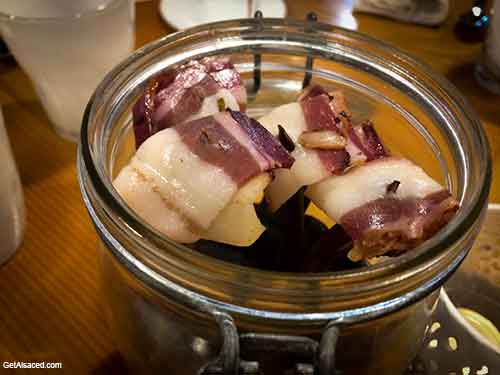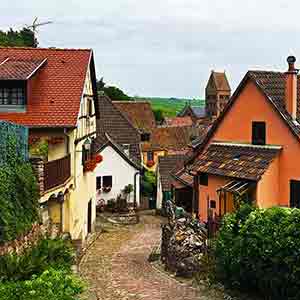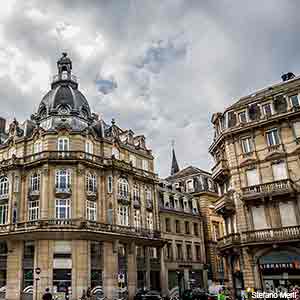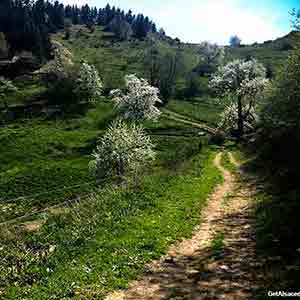Get your personalized private tour of Alsace! Click Here!
Nearly Every French Food
Word You'll Ever Need
Your French Food Dictionary for Your Next France Vacation

When I first moved to Alsace, I wish I had had a French food dictionary!
There are some things that French 101 (or even French 301) isn't going to prepare you for, like words describing meat and the different cuts of beef and pork.
So I've put this little French restaurant food dictionary together based on what I've experienced and learned about eating out in Alsace.
Feel free to suggest new entries! I'm always updating my little French food dictionary.
You can send me your suggestions here!

Hi, I'm Suzele and I'm here to help you create a more interesting, one of a kind trip to Alsace France. There is a lot of useful information that you can use to plan your trip yourself... or... I can do ALL the work for you on a private tour made just for you!
French Food Dictionary: Meat
Ways to Describe Cuts of Meat
Boulettes: normally meatballs
Carré d'Agneau: rack of lamb
Charcuterie: smoked and salted meats and sausages
Cervalas: a short fat sausage that tastes like a hot dog
Civet: ragout or stew
Collet: neck
Cote: for "boeuf", rib roast or prime rib
Cuisse: thigh, leg
Echine: spare rib
Emincé: small slices of
Entrecote: rib steak, rib-eye steak
Escalope: for "poulet", chicken breast; for all others, "chop" or "cutlet"
Faux-Filet: sirloin steak
Filet de Boeuf: tenderloin of beef
Filet Mignon: pork tenderloin
Foie: liver
Foie Gras: specially prepared duck or goose liver that tastes very differently from a normal duck or goose liver.
Gésiers: gizzards
Gigot d'Agneau: leg of lamb
Jambon: ham
Jamboneau: ham hock or ham shank cut of pork
Jaret: shank, hock, knuckle
Kassler: smoked and cured pork
Lard: bacon, not always sliced thin like in the US
Lardon: bacon, usually minced
Magret: breast, usually a duck breast
Onglet: prime cut of beef
Os: bone, as in "avec os" or bone in
Paleron: beef chuck roast
Palette: shoulder
Pavé: steak
Panaché: variety as in "a variety of..."
Pied: foot
Poitrine: pork, the cut used to make bacon
Queue: tail
Rognon: kidney
Tranches: slices
Types of Meat
Agneau: lamb or sheep
Biche: female deer
Canard: duck
Canette: young duck
Cerf: male deer
Chevre: goat, usually they're referring to cheese made from goat's milk. I have never seen goat's meat used for cooking anything in Alsace.
Chevreuil: roe deer
Coq: rooster
Crevettes: shrimp
Gambas: prawns
Grenouille: frog
Homard: lobster
Langoustine: prawns similar to lobster
Lieu: pollock, a white fish that can be substituted for Cod or Haddock.
Lotte: monkfish
Merguez: spicy north African sausage
Morue: cod
Moules: mussels
Noix de St. Jacques: scallops
Oie: goose
Pintade: guinea fowl, similar to a pheasant
Poulet: chicken
Sandre: pike perch
Sanglier: wild boar
Truite: trout
Veau: veal
Volaille: chicken or poultry
French Food Dictionary: Ways of Cooking
A la broche: rotisserie
Confit: candied or crystallized OR cooked in fat (usually its own fat if it has any fat)
Coulis: fruit purée
Croustillant: cooked in oil to the point of being crisp or crunchy
Cuite: cooked, baked, roasted
Daube: stewed, as in "en daube"
En croute: baked in a crust
Farci: stuffed
Feuilleté: enclosed in puff pastry or mille feuille pastry dough
Frite: deep-fat-fried
Fumé: smoked
Galette: thin cake usually cooked in a pan
Matelote: fish stew
Poelé: cooked in a pan in oil
Ragout: stew
Rösti: hashbrowned potatoes
Roti: roasted
Salé: cured or salt cured
Tarte: an pie with no top crust, usually a somewhat thin pie
Tartine: a piece of bread with a paste spread on it
Tiède: warm, warmed up
Tourte: a deep dish pie with a top crust
Vapeur: steamed as in "à la Vapeur"
Velouté: cream of
French Food Dictionary: Spices
Ail: garlic
Aneth: dill
Canelle: cinnamon
Cèpes: mushrooms called porcini, cep, penny bun, steinpilz
Cerfeuil: chervil, it has a lemon anise flavor
Ciboulette: chives
Gingembre: ginger
Girolle: chanterelle mushrooms
Girofle: clove
Herbes de Provence: usually a mix of basil, thyme, and oregano
Laurier: bay leaf
Morilles: morel mushrooms
Muscade: nutmeg
Oseille: sorrel, a tangy herb used in a lot of French cooking
Paprika doux: paprika
Persil: parsley
Poivre: usually black pepper
Raifort: horseradish
Sel: salt
Vegetables
Asperges: asparagus
Betterave: red sugar beet
Celeri: celeriac or celery root
Celeri en branches: celery branches (normally called Celery in the US)
Chou: cabbage
Chou de Bruxelles: brussel sprouts
Choufleur: cauliflower
Cornichon: small pickles
Echalotes: shallots
Epinards: spinach
Haricots: beans as in haricots rouges, haricots verts, etc...
Navet: turnip
Oignon: onion
Paprika: bell pepper
Poireaux: leeks
Pois: peas
Pommes de Terre: potatoes
Potiron: pumpkin
Nuts and Fruit
Agrûmes: citrus fruits
Airelles: cranberries or blueberries
Amande: almond
Cerise: cherry
Coing: quince
Fraise: strawberry
Fraise de bois: wild strawberry
Framboise: raspberry
Genièvre: juniper berry, used in Choucroute normally
Groseilles: cranberries
Quetsch: dark purple plum
Marrons: chestnuts
Merise: wild cherry
Mirabelle: small yellow plum
Myrtille: blueberry
Noisette: hazel nut
Noix: walnut
Pêche: peach
Prune: plum
Pruneau: prune
Raisin: usually it means grape
Raisin Sec: raisin, literally dry grapes
Drinks
Eau de vie: brandy, usually fruit brandy
Kir: white wine with a bit of fruit syrup, it's a popular before dinner drink or apperitif
Kir Royal: sparkling wine with a bit of fruit syrup
Liqueur: a somewhat sweet, mild alcohol
Pastis: a licorice flavored alcohol usually mixed with water and a few ice cubes, a very popular apperitif in France
Pression: draft beer
Vin chaud: hot spiced or mulled wine
More Information on Alsace Food
Shopping in French Supermarkets in Alsace
Alsatian Specialties in Restaurants
French Restaurant Food in Alsace
Alsatian Christmas Cookies: Wihnachts Bredele
Your Alsatian Food Questions Answered



